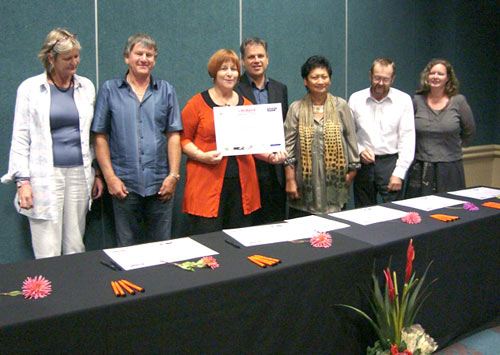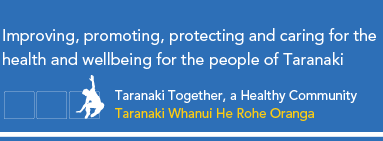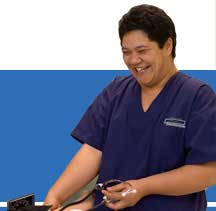
Five Midland DHBs work together to be Smokefree/Tobacco Free by 2025
5 March 2012
The five Midland DHBs have combined with the Midland Iwi Relationship Board (MIRB) to renew commitment to making their central North Island districts entirely Smokefree/Tobacco Free by 2025.
The five DHBs, Lakes, Waikato, Taranaki, Tairawhiti, Bay of Plenty and the MIRB which represents iwi in each area, signed a refreshed Smokefree Midland vision statement committing to continue to co-ordinate efforts and provide strong leadership to achieve the vision on Friday 2 March 2012 in Rotorua.
“We are united in approaching this vision with a real sense of urgency. Anything less would be failing our communities because our children deserve a future where smoking is history,” says Graeme Milne, Chair of Waikato DHB.
“Around 18 per cent of deaths in the Midland DHB areas are caused by tobacco related illnesses. This is a huge avoidable and continuing toll on individuals, families and communities, “said Graeme Milne.
District health boards have statutory responsibility for improving the health of their populations. As smoking is the single biggest preventable cause of illness and early death, DHBs and MIRB must do much more to combat smoking and achieve the vision of a Smokefree/Tobacco free Midland by 2025.
“Tobacco and smoking are too visible in our communities. Tobacco is a deadly addictive drug and our children need to grow up free from the risk of becoming addicted to it. We are committed to working with the government, territorial local authorities, iwi, community leaders, businesses and our communities to address this as a matter of urgency,” Graeme Milne says.
Chair of the Midland Iwi Relationship Board, Punohu McCausland, says iwi health boards across the five districts are totally committed to the vision.
“For Maori the impact of tobacco and smoking is even more significant. Eradicating smoking from New Zealand is the single most important and attainable policy action to reduce inequalities in mortality for Maori. The potential health benefits of stopping smoking for our children and our whanau are significant,” she says.
Four of the five Midland DHBs signed an initial Smokefree vision statement in 2009. They combined to recruit a Midland Smokefree Programme Director to provide strategic leadership in the development of the Midland Smokefree Programme. This year the vision statement has been updated to align with national work adding in the philosophy of being tobacco free. Taranaki DHB and the Midland Iwi Relationship Boards have also added their support to this significant collaboration.

Photo L-R: Mary Bourke (Chair Taranaki DHB); David Scott (Chair Tairawhiti DHB); Sally Webb (Chair Bay of Plenty DHB); Deryck Shaw (Chair Lakes DHB); Punohu McCausland (Chair Midland Iwi Relationship Board); Graeme Milne (Chair Waikato DHB) and Karen Evison (National Programme Manager, Sector Capability and Implementation, Ministry of Health).
Smokefree Midland facts
The Smokefree Midland DHBs serve a combined population of more than 700,000, including more than 215,000 Maori. National statistics indicate that about 23.5% of the population smoke tobacco, including more than 40% of Maori, and there are about 165,000 smokers in the Midland region.National Smoking Facts
- Tobacco is highly addictive
- In New Zealand, and internationally, tobacco is the single leading cause of preventable illness and death
- Around 5000 New Zealanders die each year from tobacco-related illness
- Around 400 New Zealanders die each year because of exposure to other people’s tobacco smoke making second-hand smoke the leading environmental cause of death in this country
- Smoking affects New Zealanders disproportionately
- Smoking during pregnancy increases the risk of stress during labour, low birth weight, cot death and asthma
- Some 46 per cent of Maori are current smokers compared with 21 percent of non-Maori
- Maori in all age groups have higher smoking rates than non-Maori
- Maori women have the highest recorded rates, at 49 percent
- Parents’ smoking and their attitudes about smoking are key influences in predicting whether children and young people continue to smoke
- Most Smokers want to quit
Who is quitting smoking, and what groups are struggling to do so?
A Ministry of Health publication, Tobacco Trends 2006, found almost one in every four teenagers aged 15 to 19 years smoking. Smokers are around 23.5% of the total population, with Maori (45%) and Pacific people (37%) having higher rates of smoking than other New Zealanders. 50% of Maori women are currently smokers. Tobacco Trends 2006 also found about 19% of people identifying themselves as ex-smokers, with a large proportion of them quitting smoking once they hit the age of 40.Quitting
Smoking is more expensive than it’s ever been, but there’s also more free support than ever before. Stop-smoking services include Quitline (0800 778 778), a freephone service that provides counselling and offers nicotine replacement therapy to those attempting to quit.Aukati Kai Paipa is a face-to-face service developed specifically to meet the needs of Maori women and their whanau. A range of other primary health care providers, such as Primary Health Organisations (PHOs), General Practitioners, and Pacific Health Services also offer stop-smoking services. Smokers who want to stop can also visit The Quit Group web site at www.quit.org.nz
Last updated: Thursday, March 8, 2012



